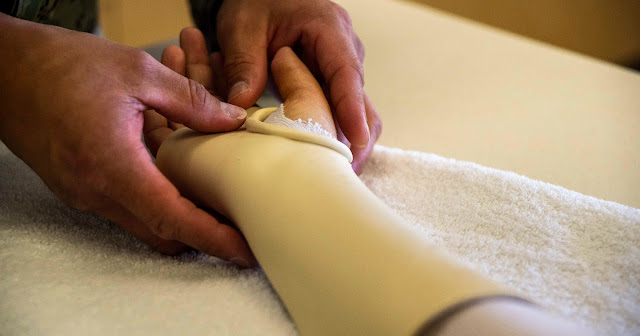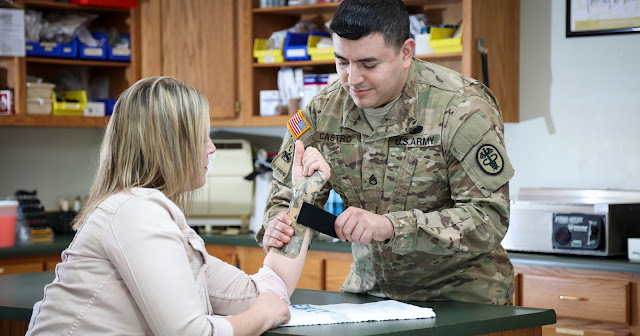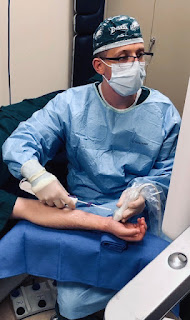USU’s MIRROR Team Investigates New Minimally-Invasive Carpal Tunnel Surgery
By Dillon Parker
The first-ever Ultrasound Guided Carpal Tunnel Release (USCTR) procedure conducted in the military was performed at the Walter Reed National Military Medical Center (WRNMMC) June 9 to kick off the Uniformed Services University’s (USU) Musculoskeletal Injury Rehabilitation Research for Operational Readiness (MIRROR) team’s clinical trial of the new procedure.
USU’s MIRROR program is on the front lines of the fight against musculoskeletal injuries, which affect approximately 800,000 service members annually and result in 25 million days of limited duty. This trial is one of the team’s 33 ongoing projects that will generate evidence-based approaches for treating and preventing these highly prevalent conditions.
The ongoing clinical trial compares the safety and efficacy of USCTR to traditional mOCTR, which is currently the most commonly utilized method to perform carpal tunnel release. Participants will be separated into two groups, with one receiving USCTR and the other traditional mOCTR. Over two years, the groups will then be compared on several variables such as pain, return to duty time, and functional return to normal activities of daily living.
“USCTR allows physicians to use ultrasound to view the anatomy in the wrist and hand prior to performing the carpal tunnel release,” said Hager. “The surgical device is passed into the carpal tunnel through a small wrist incision created with a scalpel. Once the position of the device is confirmed using ultrasound, small balloons are inflated to create space between the cutting blade and the critical anatomic structures. The blade is then activated to cut the ligament. The traditional mini-open Carpal Tunnel Release (mOCTR) procedure is a bit more invasive, typically involving opening the palm to expose the carpal tunnel.”
Carpal tunnel syndrome occurs when one of the major nerves to the hand, the median nerve, is squeezed or compressed as it travels through the wrist causing pain, numbness, and tingling in the hand and arm. According to Defense Medical Epidemiology Database information, in 2016, there were 16,823 active duty service members, across the Army, Navy, Air Force and Marines diagnosed with carpal tunnel syndrome.
“Anything we can do to cut down on the recovery time of carpal tunnel release surgery can give us a lot of lost duty days back,” said Hager. “Quicker recovery times are not only important for return to duty, they’re absolutely critical for our service members experiencing limb loss or using wheelchairs. Shorter recovery times would benefit them immediately, lower extremity limb loss and depending on assistive devices or wheelchairs for primary mobility. Shorter recovery times would benefit them immediately and allow them to get their mobility back as quickly as possible.”
USCTR may not only reduce recovery times, but it also has the potential to improve access to treatment.
“USCTR can be done by well-trained sports medicine fellowship folks with training in musculoskeletal ultrasound, in an office setting as opposed to the operating room,” said Hager. “This can increase the accessibility of the treatment, especially at more remote sites with less orthopedic capacity or limited operating room times.”
 |
| A patient is fitted with a custom-fabricated wrist orthosis, or splint, to help treat carpal tunnel. (Photo Credit: U.S. Navy photo by Mass Communication Specialist 3rd Class Luke Cunningham) |
Another crucial benefit of USCTR is that it allows physicians to see the structure of the nerves and vessels in the wrist and hand prior to and during the release, which limits the risk of neurovascular injury and makes the procedure minimally invasive.
“With advancements in ultrasound imaging and training, minimally-invasive procedures such as Carpal Tunnel Release can now be performed with maximal visualization,” notes Dr. Matthew Miller, one of the investigators on the study. “USCTR allows physicians to use ultrasound to review the anatomy in the wrist and hand throughout the procedure. This enables the clinician to assess for any unique or atypical anatomic features of concern in the surgical area of interest. The use of ultrasound also allows the clinician to enter the tunnel through a very small (< 5 mm) incision in the wrist. This avoids a palmar incision while maintaining excellent visualization of the surgical field.”
The MIRROR team is working closely with physicians from WRNMMC like Army Maj. (Dr.) David Reece, an associate investigator performing the USCTR procedure alongside Miller.
“USCTR is performed by clinicians with specialized training in musculoskeletal ultrasound techniques, in partnership with surgical colleagues like we are doing at Walter Reed.” said Hager. “We are tremendously grateful for our colleagues in the WRNMMC Department of Orthopedic Surgery who have joined this study to help investigate whether USCTR could potentially provide faster relief for our warfighters with CTS. They are equally invested in achieving decreased pain associated with the procedure and recovery, as well as the earliest return to normal activities of daily living and duty requirements.
While the procedure could potentially have a huge impact on the treatment of carpal tunnel, Hager notes this trial by the MIRROR team is ongoing.
“Before we adopt new approaches or devices, we critically examine whether it's going to make a significant difference and impact our service member’s quality of life, function, and return to duty,” said Hager. “There are many questions out there in this Musculoskeletal Arena, and we (MIRROR) look forward to finding new ways to do everything we can to optimize musculoskeletal treatment options for our warfighters.”






